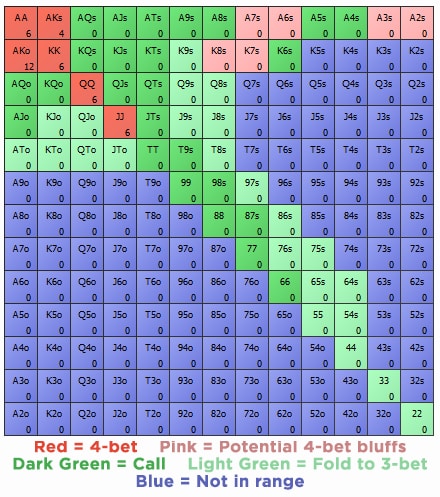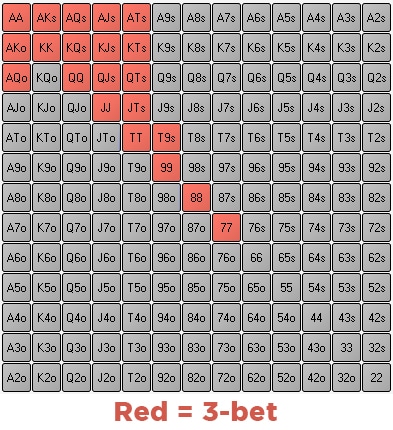Poker 3 Bet Bluff Range
Opening range charts are a dime a dozen. The aspiring player is usually very familiar with the types of hands that should be open-raised from each position on the 6-max table. What is far more confusing is the struggle that follows when those opening ranges are attacked, namely by the obnoxious 3-bet – a raise so disruptive that it often prevents us from seeing the flop. Our purpose here is to define our opening ranges from the five positions on the 6-max table where it is possible to raise as the first player into the pot, but we shall not be stopping there.
If your ranges tell you to 4bet bluff, but the 3bettor only has KK and AA in their range, you’re in for a world of hurt. There are other players like LAG’s and Maniacs who 3bet bluff a ton. You’ve seen these players 3bet with hands like JTs, 44, A5s and KJ. I was watching some videos on another training site and was really surprised by some of the hands the author used to populate the bluff side of his 3-bet range. Example: Villain opens UTG for 2.5x, hero on the button with QJo and 3-bets a full 3x, 30 BB effective.
Live Poker 131 Threads. 3 bet ranges Bluff:value ratios. Funny thing happens when we I ended up constructing BUTTON vs CO range. If I 3 bet 4% vs EP, 8% vs MP. Our 3-betting range is a strong value-oriented game. You will notice that as our opponents open in later positions, we can 3-bet wider ranges for value, especially against BTN and SB opens. We do have a 3-bet bluffing range composed of small suited aces, 22-44 and a few combos of suited connectors. The 3-bet (or more specifically, light 3-betting) is an advanced concept that adds an extra weapon to a game that has likely become repetitive and stagnant, even if that current game strategy is winning you money at the tables.
We must learn which groups of hands we should fold, call and raise with after we have opened and faced that dreaded re-raise. Colour coding shall be our friend as we learn when and how to defend our opening ranges.
The Model Situation
The recommended strategies to follow are for use in the same model situation. Assume that we have made an open raise from the relevant position and that it has folded round to the big blind, who has elected to 3-bet. This 3-bet is of a healthy size – around three times a 3BB open or a little larger if our open happened to be smaller than this. We shall be defining how our opening range from the position in question handles this 3-bet. Of course, being in position will help us flat more comfortably, and if out of position we might have to tighten the recommended flatting ranges slightly and look to open a tighter range in the first place wherever we are likely to get bombarded with 3-bets by an in position opponent.
A Rough Strategy
Poker 3 Bet Bluff Ranger
There are some hands that we shall fold to the 3-bet. After all, a balanced strategy dictates that we should not always defend. If we did, Villain would be able to make far too much money with his strong hands. Similarly, we cannot fold too much, or we make a bluff too profitable an idea for Villain.
We need to 4-bet our very best hands for value, building a large pot while our equity advantage is very high. Wherever there is a value bet, there is a bluff and so we shall use hands that are slightly too weak to call as 4-bet bluffs. This will allow us to defend more hands than we could by only calling or 4-betting for value. In order to make our opponents indifferent to bluffing us and to find an equilibrium against 3-betting, we shall look to protect 45% of our opening ranges in some way. By folding the other 55%, we give Villain some fold equity, but not enough to exploit us.
When it comes to balancing our 4-bets, we may bluff slightly more than we value-raise. This is due to the fantastic strength of our value hands, the playability and blocker value of our bluffs, and the fact that Villain will need a lot of fold equity to shove over our 4-bets lightly with 100BB stacks, provided that we keep our 4-bet between 2x and 2.5x the size of the 3-bet. We can 4-bet and fold 60% of the time to a 5-bet shove without allowing Villain to profit from 5-betting as a bluff. This allows a bluff to value ratio of roughly 1.5 to 1.
Poker 3 Bet Bluff Rangers
A Disclaimer
The following ranges are for use against an aware and aggressive regular, who knows how to apply restrained pressure with 3-bets. There will always be those opponents who are too tight, and against them, we must fold more than the 55% benchmark. On the contrary, there will be those who take the idea of a light 3-bet too far. Against maniacal 3-bet machines, we should fold less than the recommended frequency. The following ranges are nothing but a default guide to protect us against unknown or competent Villains. It is the player’s job to deviate as he or she sees fit if the opposition does not fit this description.
Also note that the opening ranges listed below are slightly on the conservative side. As your skill advantage grows, it will become feasible to widen these slightly and then defend more hands to 3-bets as a direct result.

Colour Coding
Opening range charts are a dime a dozen. The aspiring player is usually very familiar with the types of hands that should be open-raised from each position on the 6-max table. What is far more confusing is the struggle that follows when those opening ranges are attacked, namely by the obnoxious 3-bet – a raise so disruptive that it often prevents us from seeing the flop. Our purpose here is to define our opening ranges from the five positions on the 6-max table where it is possible to raise as the first player into the pot, but we shall not be stopping there.
We must learn which groups of hands we should fold, call and raise with after we have opened and faced that dreaded re-raise. Colour coding shall be our friend as we learn when and how to defend our opening ranges.
The Model Situation
The recommended strategies to follow are for use in the same model situation. Assume that we have made an open raise from the relevant position and that it has folded round to the big blind, who has elected to 3-bet. This 3-bet is of a healthy size – around three times a 3BB open or a little larger if our open happened to be smaller than this. We shall be defining how our opening range from the position in question handles this 3-bet. Of course, being in position will help us flat more comfortably, and if out of position we might have to tighten the recommended flatting ranges slightly and look to open a tighter range in the first place wherever we are likely to get bombarded with 3-bets by an in position opponent.

A Rough Strategy
There are some hands that we shall fold to the 3-bet. After all, a balanced strategy dictates that we should not always defend. If we did, Villain would be able to make far too much money with his strong hands. Similarly, we cannot fold too much, or we make a bluff too profitable an idea for Villain.
We need to 4-bet our very best hands for value, building a large pot while our equity advantage is very high. Wherever there is a value bet, there is a bluff and so we shall use hands that are slightly too weak to call as 4-bet bluffs. This will allow us to defend more hands than we could by only calling or 4-betting for value. In order to make our opponents indifferent to bluffing us and to find an equilibrium against 3-betting, we shall look to protect 45% of our opening ranges in some way. By folding the other 55%, we give Villain some fold equity, but not enough to exploit us.

When it comes to balancing our 4-bets, we may bluff slightly more than we value-raise. This is due to the fantastic strength of our value hands, the playability and blocker value of our bluffs, and the fact that Villain will need a lot of fold equity to shove over our 4-bets lightly with 100BB stacks, provided that we keep our 4-bet between 2x and 2.5x the size of the 3-bet. We can 4-bet and fold 60% of the time to a 5-bet shove without allowing Villain to profit from 5-betting as a bluff. This allows a bluff to value ratio of roughly 1.5 to 1.
A Disclaimer
The following ranges are for use against an aware and aggressive regular, who knows how to apply restrained pressure with 3-bets. There will always be those opponents who are too tight, and against them, we must fold more than the 55% benchmark. On the contrary, there will be those who take the idea of a light 3-bet too far. Against maniacal 3-bet machines, we should fold less than the recommended frequency. The following ranges are nothing but a default guide to protect us against unknown or competent Villains. It is the player’s job to deviate as he or she sees fit if the opposition does not fit this description.
Also note that the opening ranges listed below are slightly on the conservative side. As your skill advantage grows, it will become feasible to widen these slightly and then defend more hands to 3-bets as a direct result.